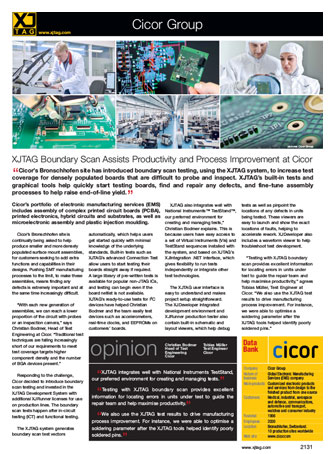Cicor’s Bronschhofen site has introduced boundary scan testing, using the XJTAG system, to increase test coverage for densely populated boards that are difficult to probe and inspect. XJTAG’s built-in tests and graphical tools help quickly start testing boards, find and repair any defects, and fine-tune assembly processes to help raise end-of-line yield.
Cicor’s portfolio of electronic manufacturing services (EMS) includes assembly of complex printed circuit boards (PCBA), printed electronics, hybrid circuits and substrates, as well as microelectronic assembly and plastic injection moulding.
Cicor’s Bronschhofen site is continually being asked to help produce smaller and more densely populated surface mount assemblies, for customers seeking to add extra functions and capabilities in their designs. Pushing SMT manufacturing processes to the limit, to make these assemblies, means finding any defects is extremely important and at the same time increasingly difficult.
“With each new generation of assemblies, we can reach a lower proportion of the circuit with probes or an inspection camera,” says Christian Bodmer, Head of Test Engineering at Cicor. “Traditional test techniques are falling increasingly short of our requirements to meet test coverage targets higher component density and the number of BGA devices present.”
Responding to the challenge, Cicor decided to introduce boundary scan testing and invested in the XJTAG Development System with additional XJRunner licenses for use on production lines. The boundary scan tests happen after in-circuit testing (ICT) and functional testing.
The XJTAG system generates boundary scan test vectors automatically, which helps users get started quickly with minimal knowledge of the underlying standards. Built-in tests such as XJTAG’s advanced Connection Test allow users to start testing their boards straight away if required.
A large library of pre-written tests is available for popular non-JTAG ICs, and testing can begin even if the board netlist is not available. XJTAG’s ready-to-use tests for I2C devices have helped Christian Bodmer and the team easily test devices such as accelerometers, real-time clocks, and EEPROMs on customers’ boards.
XJTAG also integrates well with National Instruments™ TestStand™, our preferred environment for creating and managing tests,” Christian Bodmer explains. This is because users have easy access to a set of Virtual Instruments (VIs) and TestStand sequences installed with the system, and based on XJTAG’s XJIntegration .NET interface, which gives flexibility to run tests independently or integrate other test technologies.
The XJTAG user interface is easy to understand and makes project setup straightforward. The XJDeveloper integrated development environment and XJRunner production tester also contain built-in schematic and layout viewers, which help debug tests as well as pinpoint the locations of any defects in units being tested. These viewers are easy to launch and show the exact locations of faults, helping to accelerate rework. XJDeveloper also includes a waveform viewer to help troubleshoot test development.
“Testing with XJTAG boundary scan provides excellent information for locating errors in units under test to guide the repair team and help maximise productivity,” agrees Tobias Müller, Test Engineer at Cicor. “We also use the XJTAG test results to drive manufacturing process improvement. For instance, we were able to optimise a soldering parameter after the XJTAG tools helped identify poorly soldered pins.”







